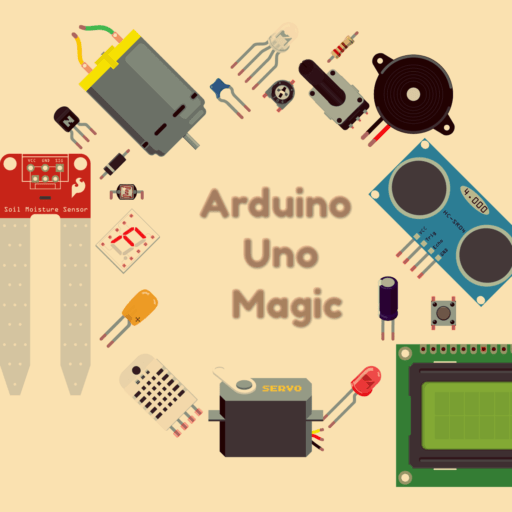Dive into a hands-on tutorial on how to drive an NPN transistor ( 2N2222) as a switch using Arduino uno. Craft your projects with this comprehensive guide.

Basics of Transistor
A transistor is an electronic component used for amplifying or switching electronic signals. It is a semiconductor device with three layers of material: the emitter, base, and collector. Transistors are fundamental building blocks of modern electronics and have revolutionized the technology field.
There are two main types of transistors: bipolar junction transistors (BJTs) and field-effect transistors (FETs). BJTs are current-controlled devices and are further categorized as NPN (negative-positive-negative) and PNP (positive-negative-positive) transistors. On the other hand, FETs are voltage-controlled devices and can be classified as either MOSFETs (metal-oxide-semiconductor field-effect transistors) or JFETs (junction field-effect transistors).
Transistors have played a crucial role in the miniaturization and advancement of electronics. They can amplify weak signals, switch electronic currents on and off, and perform logic operations. They are commonly found in devices such as computers, smartphones, televisions, radios, and many other electronic systems.
NPN Transistor with Arduino
Transistors are commonly used in conjunction with Arduino boards to control higher currents or voltages that the microcontroller itself cannot handle directly. For example, a transistor can be used to switch on and off a motor, control the brightness of an LED, or drive larger loads such as relays or solenoids.
By using transistors in combination with Arduino, users can interface with a wide range of external devices and sensors, expanding the capabilities of their projects. Arduino’s simplicity and versatility make it a popular choice for hobbyists, students, and professionals alike who want to create interactive and programmable electronic systems.
Which type of transistor is best suited for Arduino uno
Arduino boards typically use NPN (Negative-Positive-Negative) transistors for most applications. NPN transistors are commonly used in low-side switching configurations, where the load is connected between the positive power supply and the collector of the transistor.
When using an NPN transistor with an Arduino, the base of the transistor is connected to a digital output pin of the Arduino through a current-limiting resistor. By controlling the state (HIGH or LOW) of the digital output pin, the Arduino can control the current flow through the transistor, thus switching the connected load on or off.
PNP (Positive-Negative-Positive) transistors can also be used with Arduino, but they are less commonly employed. PNP transistors are used in high-side switching configurations, where the load is connected between the collector and the positive power supply. Using PNP transistors requires different circuit configurations and often additional components like level-shifting circuits to accommodate the voltage differences between the Arduino and the load.
In summary, NPN transistors are the more prevalent choice for most Arduino board applications due to their ease of use and compatibility with low-side switching configurations.
What will you learn from this article
In this article, I will share how the NPN transistor can be used with Arduino to operate a DC motor using a push button. It’s an elementary example, that helps you to understand the basics of transistors working with Arduino UNo.
If you need to know more about DC motor and push button go and check out my detailed article on both. it will help you to understand all the basics about them.
Gather the components
- Arduino uno board: BUY ON AMAZON
- Breadboard: BUY ON AMAZON
- 2 * 220 ohm resistors: BUY ON AMAZON
- NPN transistor (2N2222): BUY ON AMAZON
- 1N4007 Diode: BUY ON AMAZON
- Few jumper wires: BUY ON AMAZON
- Push button: BUY ON AMAZON
Circuit diagram

As shown in the above connection diagram make the connections:
- Place the NPN transistor on the breadboard.
- Place the push button on the Breadboard
- Place both resistors on the Breadboard
- Connect the emitter to the GND terminal of the Arduino
- Connect the base terminal to the one terminal of the 220-ohm resistor
- The other terminal of the 220-ohm resistor is connected to PIN 9 of the Arduino Board.
- The collector terminal of the transistor is connected to the diode’s positive terminal and the DC motor’s one end.
- The negative terminal of the diode is connected to the other end of the DC motor and one terminal of the push button and 5-volt power supply of the Arduino uno board.
- the other 220 ohm resistors one end is connected to the push button and PIN 7 of the Arduino board and the other terminal is connected to the GND pin of the Arduino uno board.
This was all about the circuit connection basics, now let’s see the coding details.
Code
////Transistor using Arduino
//how to operate DC motor using push button
//Copyright (C) 2007 Free Software Foundation, Inc. <[email protected]>
//For more details please visit:https://www.arduinounomagic.com/how-to-drive-an-npn-transistor-2n2222-as-a-switch-using-arduino/
//for more projects please visit://www.arduinounomagic.com
//
const int motor=9;//connect DC motor at analog pin 5
const int push_button = 7; // push button is connected to digital pin number 7
int button_state = 0;//intiallize the state of button
void setup()
{
pinMode(motor, OUTPUT);//define motor as output
pinMode(push_button, INPUT); //define pushbutton as Input
}
void loop()
{
button_state= digitalRead(push_button); //read the status of the push button
if (button_state == 1) //check the status of the push button ethier HIGH or LOW
{
digitalWrite(motor, 1); //if condition is true, motor turns on
}
else
{
digitalWrite(motor, 0); //if condition is false, Lmotor turns off
}
delay(50);//delay
}Output
Check out the output video of the simulator to understand the working of the code in real-time.
Hope you find the article helpful.
If you have any questions, feel free to ask in the comments.












